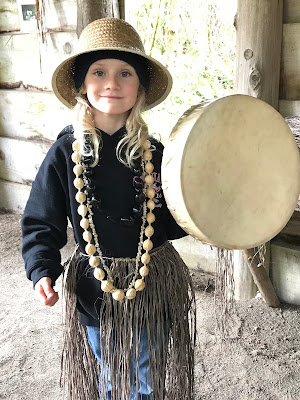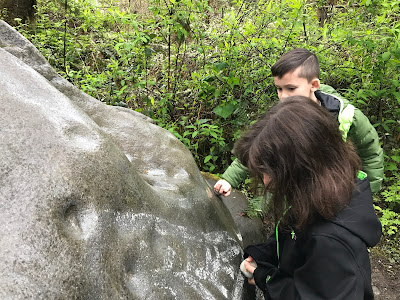Ready? Set? Touch everything!
(Except for the poisonous plants!)
Welcome to the Ohop Indian Village
The Valley of the Sound of Rushing Water
The Navigators and the Gemstones went back in time before
Walmarts and Costcos
Electricity and running water
Iphones and Ipads
and learned how to survive and thrive
as Native American Ohop children.
To the Native Americans, the forest was their home, their play ground, their school, their grocery store, their pharmacy, their lumber yard, their hardware store, their everything! No wonder they highly respected and took good care of it!
We had done a lot of reading and activities at school but there is nothing like rolling up your sleeves and experiencing it!
Pounding soaked cedar bark into soft fibers
These soft fibers can then be twisted together into cordage and made into cloth.
Can you guess what this is?
Answer at bottom of blog :)
Making ornamental jewelry
A bentwood box like the one in the book Raven
In this trickster tale, the raven found the sun in a box and brought it back to his people.
Tanning a deer hide
Making yarn out of bighorn sheep or goat wool
Giving weaving a try--over, under, over, under...
Trying on the what boys would wear.
Tule reed, wheat grass and and bear grass were all used to make clothing.
This student is part Cowlitz and she brought her own personal drum.
A basket made from cattail reeds
This basket, called the Mount Rainier basket, is made from bear grass, a light colored grass that dyes well.
(We were asked to not touch this very old artifact.)
A shirt made from grasses
Making our mark for the future--a harbor seal petroglyph
Play is an important part of a Native American child.
It is a way to learn the skills necessary for survival.
A spontaneous group game of ring toss
Spear throwing practice
Sharpening a slate arrowhead
Learning how to be still, aim and hit a target
How did I do?
Ironwood is good for nails, staffs and arrows because it is straight and strong.
Ironwood also resists heat and is good for picking up hot rocks.
The hot rocks are used to boil water.
A stick, a rock, and a bone make a fine working drill.
Various types of canoes for various types of uses
Hollowing out a future canoe
Making music on a plank drum
They called their group "Native Awesome."
Ready for part 2 of our trip
The native plant nature hike
The shaman was an expert on all plants.
But each person was responsible for developing their own "special eye"
for a specific plant
so that they could look at a plant and know if it was good or bad.
This was a way to keep the community
healthy and safe.
But each person was responsible for developing their own "special eye"
for a specific plant
so that they could look at a plant and know if it was good or bad.
This was a way to keep the community
healthy and safe.
She taught us about plants that are beneficial for diarrhea and for upset stomach,
plants that stimulate appetite and plants that suppress it,
plants that are edible and full of good vitamins and plants that are poisonous,
plants that sting us (stinging nettle) and plants that take the sting away (fern)
and much more.
plants that stimulate appetite and plants that suppress it,
plants that are edible and full of good vitamins and plants that are poisonous,
plants that sting us (stinging nettle) and plants that take the sting away (fern)
and much more.
 |
| False Solomon's Seal A powerful narcotic pain reliever  Trillium--a time teller Goes from white to pink to purple throughout the season |
The cedar tree--the "tree of life" for Pacific Northwest Native Americans
This tree is over 250 feet tall and is therefore over 250 years old.
One Navigator expresses our feelings best!
Answer to the "what is it" question:
Put some some moss or animal fur in the center
Attach it to baby
and voila
A DIAPER!

































No comments:
Post a Comment